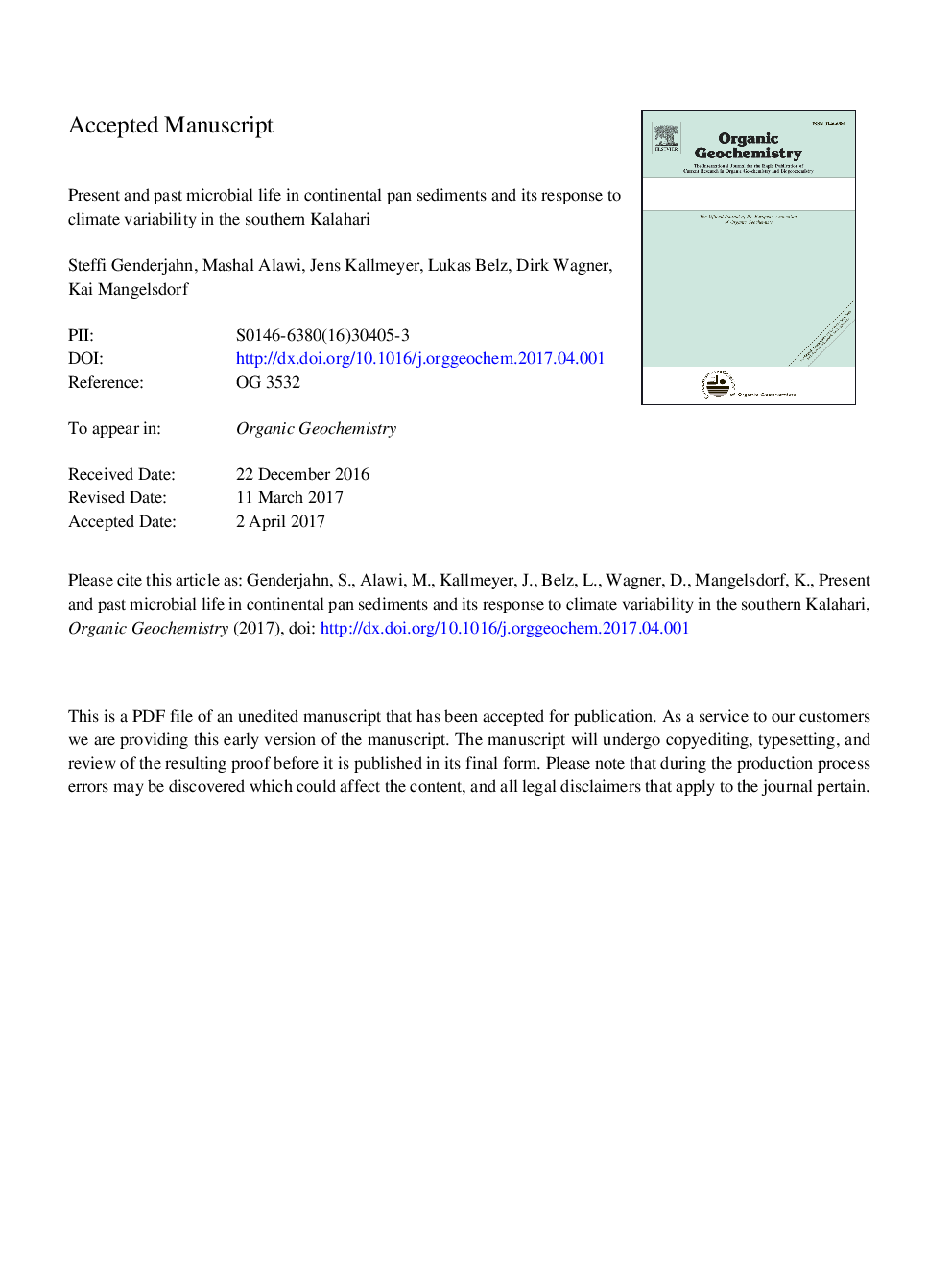| کد مقاله | کد نشریه | سال انتشار | مقاله انگلیسی | نسخه تمام متن |
|---|---|---|---|---|
| 5161376 | 1502255 | 2017 | 46 صفحه PDF | دانلود رایگان |
عنوان انگلیسی مقاله ISI
Present and past microbial life in continental pan sediments and its response to climate variability in the southern Kalahari
دانلود مقاله + سفارش ترجمه
دانلود مقاله ISI انگلیسی
رایگان برای ایرانیان
کلمات کلیدی
موضوعات مرتبط
مهندسی و علوم پایه
شیمی
شیمی آلی
پیش نمایش صفحه اول مقاله

چکیده انگلیسی
Terrestrial climate archives are rare in the arid southwestern African region, which makes paleoclimate and paleoenvironmental studies difficult. Since there are only ephemeral lacustrine systems in the area, in this study a continental pan (playa) is evaluated as a climate archive. Climate has a strong impact on the pan ecosystem, causing adaptation of indigenous microorganisms to varying temperature, precipitation and salinity conditions. Here a combined approach of inorganic and organic geochemical investigations, including lipid biomarker analyses, was carried out to examine the response of indigenous microbial communities to environmental changes and to characterize the nature, abundance and depth distribution of recent (phospholipids) and past (glycerol dialkyl glycerol tetraethers, GDGTs) microbial life within the sediments of Witpan, located in the southern Kalahari. Lipid biomarkers contain information about changes in biogeochemical processes and climate variation, therefore we tested here whether they can be used to reconstruct paleoclimatic changes such as past precipitation periods in arid terrestrial ecosystems. Despite the extreme environmental conditions with rather low TOC values, restricted availability of water and substrates in the pan system, bacterial life was observed along the depth profile of Witpan. Bacterial membrane phospholipid life markers showed their highest abundance in the surface layers, indicating that microbial life in Witpan is strongly influenced by near-surface processes. A series of saturated, branched and unsaturated phospholipid fatty acids (PLFAs) were detected and several phyla of Bacteria, such as gram-positive and gram-negative bacteria were present. Some PLFAs and intact archaeal membrane lipids point to the presence of a halophilic microbial community in the surface layers. Biomarkers for past microbial life (archaeol, branched and isoprenoid GDGTs) were absent or had very low concentrations during the dry Holocene sequence (below the surface sediments). However, during the Last Glacial Maximum (LGM), considered to represent a period with increased precipitation, an increased abundance of these biomarkers was observed. Thus, these results demonstrate the potential of microbial biomarkers in pan systems to preserve climate signals over geologic timescales. The data indicates that microbial biomarkers can be used to trace paleo-precipitation periods in semi-arid to arid environments and that pan structures can form suitable geo-archives for biomolecules in areas where other terrestrial archives are missing.
ناشر
Database: Elsevier - ScienceDirect (ساینس دایرکت)
Journal: Organic Geochemistry - Volume 108, June 2017, Pages 30-42
Journal: Organic Geochemistry - Volume 108, June 2017, Pages 30-42
نویسندگان
Steffi Genderjahn, Mashal Alawi, Jens Kallmeyer, Lukas Belz, Dirk Wagner, Kai Mangelsdorf,